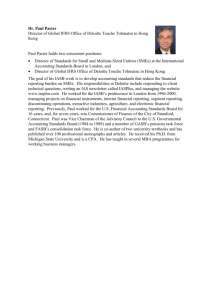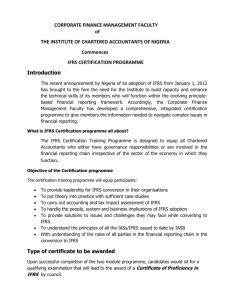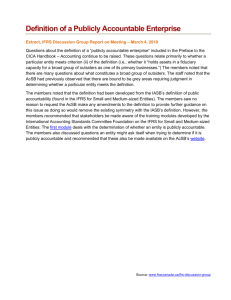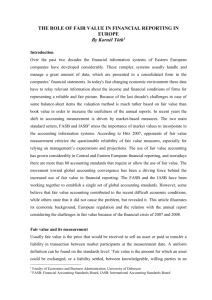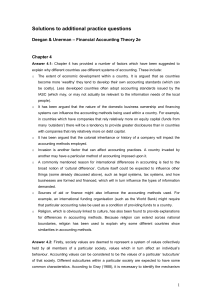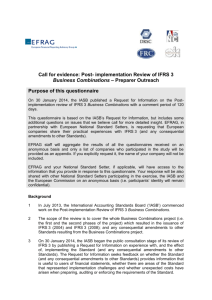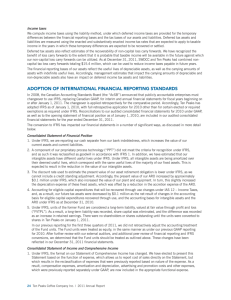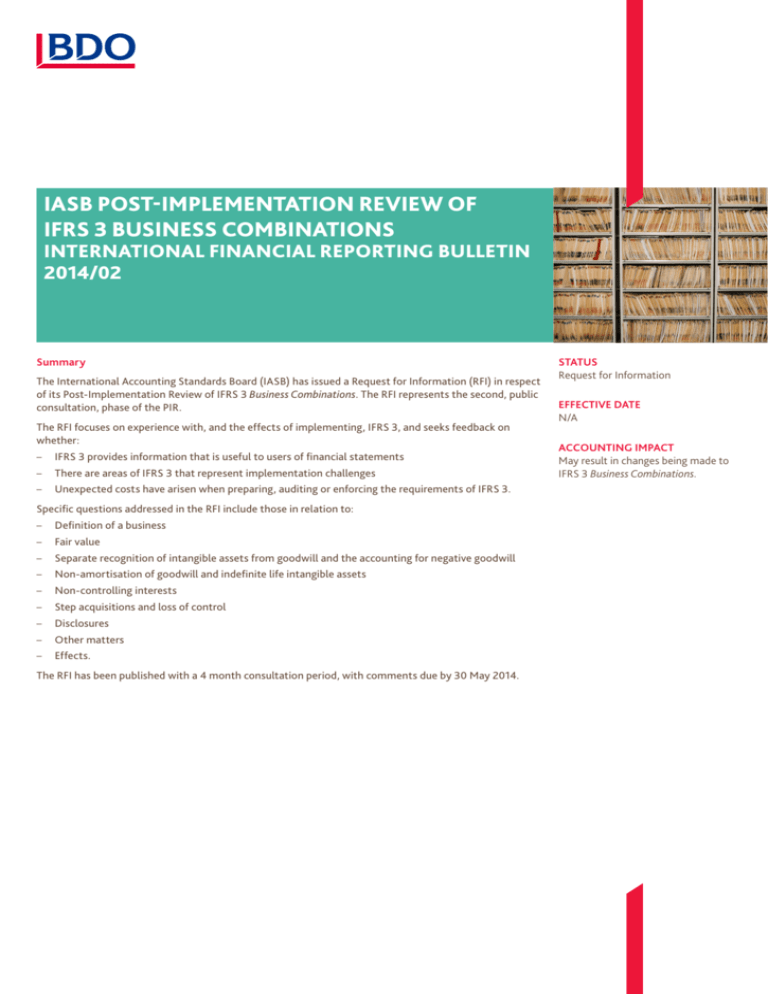
IASB POST-IMPLEMENTATION REVIEW OF
IFRS 3 BUSINESS COMBINATIONS
INTERNATIONAL FINANCIAL REPORTING BULLETIN
2014/02
Summary
The International Accounting Standards Board ­(IASB) has issued a Request for Information (RFI) in respect
of its Post-Implementation Review of IFRS 3 Business Combinations. The RFI represents the second, public
consultation, phase of the PIR.
The RFI focuses on experience with, and the effects of implementing, IFRS 3, and seeks feedback on
whether:
–– IFRS 3 provides information that is useful to users of financial statements
–– There are areas of IFRS 3 that represent implementation challenges
–– Unexpected costs have arisen when preparing, auditing or enforcing the requirements of IFRS 3.
Specific questions addressed in the RFI include those in relation to:
–– Definition of a business
–– Fair value
–– Separate recognition of intangible assets from goodwill and the accounting for negative goodwill
–– Non‐amortisation of goodwill and indefinite life intangible assets
–– Non‐controlling interests
–– Step acquisitions and loss of control
–– Disclosures
–– Other matters
–– Effects.
The RFI has been published with a 4 month consultation period, with comments due by 30 May 2014.
STATUS
Request for Information
EFFECTIVE DATE
N/A
ACCOUNTING IMPACT
May result in changes being made to
IFRS 3 Business Combinations.
2
IFRB 2014/02 IASB POST-IMPLEMENTATION REVIEW OF IFRS 3 BUSINESS COMBINATIONS
Background on the Business Combination project
The predecessor of IFRS 3 Business Combinations, IAS 22 Accounting
for Business Combinations, was originally released in November 1983.
When the International Accounting Standards Board (IASB) was
formed in 2001, the Business Combination project was initiated as
there was significant divergence within and across various jurisdictions
in the application of IAS 22 (the most recent revision of which was
issued in 1998).
The IASB decided to approach the project to replace IAS 22 in
two phases. Both phases started at the same time and ran parallel to
each other, until the completion of the first phase:
–– Phase 1: Short-term project focussing on specific areas of
significant (i.e. pooling of interest method, goodwill
impairment and amortisation)
–– Phase 2: Longer-term project looking at broader issues in business
combination accounting.
An exposure draft was released in December 2002 which also included
consequential amendments to IAS 36 Impairment of Assets and
IAS 38 Intangible Assets, and attracted 136 comment letters from
constituents.
IFRS 3 Business Combinations was then released in March 2004,
signalling the end of Phase 1 of the Business Combinations project.
Significant changes to the then current practice under IAS 22 included:
Area of change from IAS 22
Details
Overall treatment
–– Acquisition method is the only allowed method
–– Pooling of interest method no longer permitted.
Terminating or reducing activities of the
acquiree and contingent liabilities
–– Separate recognition only when liabilities of the acquiree at the acquisition date in
accordance with IAS 37 Provisions, Contingent Liabilities and Contingent Assets
–– No longer included in the cost of acquisition.
Intangible assets
–– Probability criteria always assumed to have been met in a business combination.
Amortisation of indefinite-lived intangible
assets and goodwill
–– Discontinued. Instead these items must be tested annually for impairment.
‘Negative goodwill’
–– Recognised in profit or loss at acquisition date.
Figure 1 – Significant changes made to business combination accounting upon the release of IFRS 3 (2004)
IFRB 2014/02 IASB POST-IMPLEMENTATION REVIEW OF IFRS 3 BUSINESS COMBINATIONS
Phase 2 of the Business Combinations project continued on after the
release of IFRS 3 (2004), culminating in the release of an exposure
draft issued in 2005 prosing revisions to IFRS 3 (2004). This attracted
280 comment letters from constituents.
IFRS 3 (Revised) was then released in January 2008.
Significant changes from IFRS 3 (2004) included:
Area of change from IFRS 3 (2004)
Details
Scope
–– Business combinations involving only mutual entities are in the scope of IFRS 3
–– Business combinations achieved by contract alone are added to the scope of IFRS 3.
Transaction costs
–– Recognised in profit or loss as expenses when incurred (not capitalised as part of the cost
of acquisition).
Contingent consideration
–– Recognised at its acquisition date fair value
–– Subsequent changes in fair value are recognised in profit or loss.
Non-controlling interest (NCI)
–– Choice of measurement between:
–– Fair value
–– Proportionate share of acquisition date fair value of net identifiable assets.
Goodwill in a step acquisition
–– Simplification of measurement.
Acquisition and disposal of NCIs
–– Accounted for as equity transactions.
Attributing total comprehensive to NCIs
–– Requirement to attribute (which may result in a negative NCI balance).
Additional guidance
–– Additional guidance provided for accounting for:
–– Reacquired rights
–– Indemnification assets
–– Leases and insurance contracts
–– Contingent liabilities.
Figure 2 – Significant changes made to business combination accounting upon the release of IFRS 3 (2008)
The current RFI regarding the Post-Implementation Review of
IFRS 3 has been issued in accordance with the requirements of the
IFRS Foundation Due Process Handbook, which requires the IASB to
conduct such a review after the release of each new standard or major
amendment. The purpose of the Post-Implementation Review is to
assess the effect of the new requirements on investors, preparers,
and auditors. The review considers issues that were important or
contentious during the development of IFRS , together with those
which have come to the attention of the IASB since its publication.
In addition to the RFI, the IASB plans to undertake a range of outreach
activities around the globe.
3
4
IFRB 2014/02 IASB POST-IMPLEMENTATION REVIEW OF IFRS 3 BUSINESS COMBINATIONS
Areas on which the IASB is seeking feedback
The RFI includes 10 questions, which themselves include various other
questions.
Question 1 simply serves as an information gathering tool for the IASB
so that it is able to disaggregate responses from constituents based
on their role (i.e. user, preparer, regulator, auditor etc.), and on
jurisdiction.
The other 9 areas on which the IASB is seeking feedback, and a
summary of the questions asked are detailed below.
Area of questioning
Summary of details
Definition of a business
–– Are there benefits of having separate accounting treatments for business combinations
and asset acquisitions?
–– What are the main practical implementation, auditing or enforcement challenges related
to the definition of a business?
Fair value
–– Are fair value measurements relevant?
–– What are the main valuation, auditing or enforcement challenges related to fair value
measurement?
–– Are fair value measurements more challenging for particular elements?
Separate recognition of intangible assets
from goodwill and the accounting for
negative goodwill
–– Is the separate recognition of intangible assets from goodwill useful, and are changes
needed?
–– What are the main implementation, auditing or enforcement challenges related to the
separate recognition of intangible assets from goodwill?
–– Is the recognition and additional disclosure related to negative goodwill useful?
Non‐amortisation of goodwill and
indefinite life intangible assets
–– Is the information obtained during the mandatory annual impairments testing of goodwill
and indefinite life intangible assets useful?
–– Are improvements needed to the information provided?
–– What are the main implementation, auditing or enforcement challenges related to the
mandatory annual impairment testing of goodwill and indefinite life intangible assets?
Non‐controlling interests (NCI)
–– Is the information regarding the presentation and measurement of NCI useful?
–– Are improvements needed to the information provided?
–– What are the main accounting, auditing or enforcement challenges related to the
accounting of NCI?
Step acquisitions and loss of control
–– Is the information regarding step acquisitions in IFRS 3 useful?
–– Is the information regarding the retained interest in a formerly controlled entity
(i.e. a subsidiary) useful?
Disclosures
–– What, if any, additional information is required to understand the effect of an acquisition
on a group?
–– Are there any current disclosure requirements that are not useful?
–– What are the main preparation, auditing or enforcement challenges related to IFRS 3
disclosures?
Other matters
–– Are there any other matters the IASB should be aware of?
Effects of the revision to IFRS 3 in 2008
–– Which areas of the 2008 revision to IFRS 3:
–– Have resulted in benefits?
–– Have resulted in unexpected costs?
–– Have had an effect on how business combinations are carried out in practice?
Figure 3 – Summary of questions included in the IASB’s RFI
IFRB 2014/02 IASB POST-IMPLEMENTATION REVIEW OF IFRS 3 BUSINESS COMBINATIONS
Comment period
The IASB’s Request for Information relating to the Post-Implementation
Review of IFRS 3: Business Combinations has been published with a
4 month consultation period, with comments due by 30 May 2014.
5
This publication has been carefully prepared, but it has been written in general terms and should be seen as broad guidance only. The publication cannot be relied upon to cover specific situations and you should not act, or refrain from acting, upon the information contained therein without obtaining specific professional advice. Please contact your respective
BDO member firm to discuss these matters in the context of your particular circumstances. Neither BDO IFR Advisory Limited, Brussels Worldwide Services BVBA, BDO International Limited and/or BDO member firms, nor their respective partners, employees and/or agents accept or assume any liability or duty of care for any loss arising from any action
taken or not taken by anyone in reliance on the information in this publication or for any decision based on it.
Service provision within the international BDO network of independent member firms (‘the BDO network’) in connection with IFRS (comprising International Financial Reporting
Standards, International Accounting Standards, and Interpretations developed by the IFRS Interpretations Committee and the former Standing Interpretations Committee), and
other documents, as issued by the International Accounting Standards Board, is provided by BDO IFR Advisory Limited, a UK registered company limited by guarantee. Service
provision within the BDO network is coordinated by Brussels Worldwide Services BVBA, a limited liability company incorporated in Belgium with its statutory seat in Brussels.
Each of BDO International Limited (the governing entity of the BDO network), Brussels Worldwide Services BVBA, BDO IFR Advisory Limited and the member firms is a separate legal entity and has no liability for another such entity’s acts or omissions. Nothing in the arrangements or rules of the BDO network shall constitute or imply an agency relationship
or a partnership between BDO International Limited, Brussels Worldwide Services BVBA, BDO IFR Advisory Limited and/or the member firms of the BDO network.
BDO is the brand name for the BDO network and for each of the BDO member firms.
© 2014 BDO IFR Advisory Limited, a UK registered company limited by guarantee. All rights reserved.
1403-02
www.bdointernational.com


